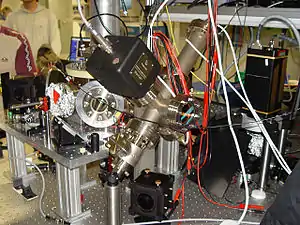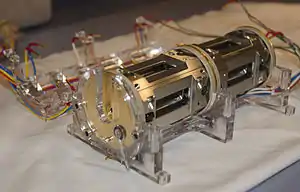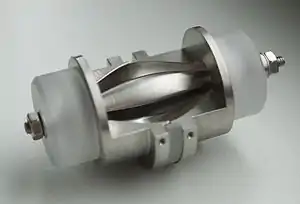Ion trap
An ion trap is a combination of electric or magnetic fields used to capture charged particles — known as ions — often in a system isolated from an external environment. Ion traps have a number of scientific uses such as mass spectrometry, basic physics research, and controlling quantum states. The two most common types of ion trap are the Penning trap, which forms a potential via a combination of electric and magnetic fields, and the Paul trap which forms a potential via a combination of static and oscillating electric fields.

Penning traps can be used for precise magnetic measurements in spectroscopy. Studies of quantum state manipulation most often use the Paul trap. This may lead to a trapped ion quantum computer[1] and has already been used to create the world's most accurate atomic clocks.[2][3] Electron guns (a device emitting high-speed electrons, used in CRTs) can use an ion trap to prevent degradation of the cathode by positive ions.
Ion trap mass spectrometers

An ion trap mass spectrometer may incorporate a Penning trap (Fourier transform ion cyclotron resonance),[4] Paul trap[5] or the Kingdon trap.[6] The Orbitrap, introduced in 2005, is based on the Kingdon trap.[7] Other types of mass spectrometers may also use a linear quadrupole ion trap as a selective mass filter.
Penning ion trap
_Mass_spectrometer.jpg.webp)
A Penning trap stores charged particles using a strong homogeneous axial magnetic field to confine particles radially and a quadrupole electric field to confine the particles axially.[8] Penning traps are well suited for measurements of the properties of ions and stable charged subatomic particles. Precision studies of the electron magnetic moment by Dehmelt and others are an important topic in modern physics.
Penning traps can be used in quantum computation and quantum information processing[9] and are used at CERN to store antimatter. Penning traps form the basis of Fourier transform ion cyclotron resonance mass spectrometry for determining the mass-to-charge ratio of ions.[10]
The Penning Trap was invented by Frans Michel Penning and Hans Georg Dehmelt, who built the first trap in the 1950s.[11]
Paul ion trap

A Paul trap is a type of quadrupole ion trap that uses static direct current (DC) and radio frequency (RF) oscillating electric fields to trap ions. Paul traps are commonly used as components of a mass spectrometer. The invention of the 3D quadrupole ion trap itself is attributed to Wolfgang Paul who shared the Nobel Prize in Physics in 1989 for this work.[12][13] The trap consists of two hyperbolic metal electrodes with their foci facing each other and a hyperbolic ring electrode halfway between the other two electrodes. Ions are trapped in the space between these three electrodes by the oscillating and static electric fields.
Kingdon trap and orbitrap

A Kingdon trap consists of a thin central wire, an outer cylindrical electrode and isolated end cap electrodes at both ends. A static applied voltage results in a radial logarithmic potential between the electrodes.[14] In a Kingdon trap there is no potential minimum to store the ions; however, they are stored with a finite angular momentum about the central wire and the applied electric field in the device allows for the stability of the ion trajectories.[15] In 1981, Knight introduced a modified outer electrode that included an axial quadrupole term that confines the ions on the trap axis.[16] The dynamic Kingdon trap has an additional AC voltage that uses strong defocusing to permanently store charged particles.[17] The dynamic Kingdon trap does not require the trapped ions to have angular momentum with respect to the filament. An Orbitrap is a modified Kingdon trap that is used for mass spectrometry. Though the idea has been suggested and computer simulations performed[18] neither the Kingdon nor the Knight configurations were reported to produce mass spectra, as the simulations indicated mass resolving power would be problematic.
Cathode ray tubes
Ion traps were used in television receivers prior to the introduction of aluminized CRT faces around 1958, to protect the phosphor screen from ions.[19] The ion trap must be delicately adjusted for maximum brightness.[20][21]
Trapped ion quantum computer
Some experimental work towards developing quantum computers use trapped ions. Units of quantum information called qubits are stored in stable electronic states of each ion, and quantum information can be processed and transferred through the collective quantized motion of the ions, interacting by the Coulomb force. Lasers are applied to induce coupling between the qubit states (for single qubit operations) or between the internal qubit states and external motional states (for entanglement between qubits).
References
- R. Blatt; D. J. Wineland (2008). "Entangled states of trapped atomic ions" (PDF). Nature. 453 (7198): 1008–1014. Bibcode:2008Natur.453.1008B. doi:10.1038/nature07125. PMID 18563151. S2CID 316118.
- T. Rosenband; D. B. Hume; P. O. Schmidt; C. W. Chou; A. Brusch; L. Lorini; W. H. Oskay; R. E. Drullinger; T. M. Fortier; J. E. Stalnaker; S. A. Diddams; W. C. Swann; N. R. Newbury; W. M. Itano; D. J. Wineland; J. C. Bergquist (2008). "Frequency Ratio of Al+ and Hg+ Single-Ion Optical Clocks; Metrology at the 17th Decimal Place" (PDF). Science. 319 (5871): 1808–1812. Bibcode:2008Sci...319.1808R. doi:10.1126/science.1154622. PMID 18323415. S2CID 206511320.
- S. M. Brewer; J.-S. Chen; A. M. Hankin; E. R. Clements; C. W. Chou; D. J. Wineland; D. B. Hume; D. R. Leibrandt (2019). "Al+ Quantum-Logic Clock with a Systematic Uncertainty below 10^-18". Phys. Rev. Lett. 123 (3): 033201. arXiv:1902.07694. Bibcode:2019PhRvL.123c3201B. doi:10.1103/PhysRevLett.123.033201. PMID 31386450. S2CID 119075546.
- Blaum, Klaus (2006). "High-accuracy mass spectrometry with stored ions". Physics Reports. 425 (1): 1–78. Bibcode:2006PhR...425....1B. doi:10.1016/j.physrep.2005.10.011.
- Douglas, DJ; Frank, AJ; Mao, DM (2005). "Linear ion traps in mass spectrometry". Mass Spectrometry Reviews. 24 (1): 1–29. Bibcode:2005MSRv...24....1D. doi:10.1002/mas.20004. PMID 15389865.
- Kingdon KH (1923). "A Method for the Neutralization of Electron Space Charge by Positive Ionization at Very Low Gas Pressures". Physical Review. 21 (4): 408–418. Bibcode:1923PhRv...21..408K. doi:10.1103/PhysRev.21.408.
- Hu, QZ; Noll, RJ; Li, HY; Makarov, A; Hardman, M; Cooks, RG (2005). "The Orbitrap: a new mass spectrometer". Journal of Mass Spectrometry. 40 (4): 430–443. Bibcode:2005JMSp...40..430H. doi:10.1002/jms.856. PMID 15838939.
- Brown, L.S.; Gabrielse, G. (1986). "Geonium theory: Physics of a single electron or ion in a Penning trap" (PDF). Reviews of Modern Physics. 58 (1): 233–311. Bibcode:1986RvMP...58..233B. doi:10.1103/RevModPhys.58.233.
- Häffner, Hartmut, Christian F. Roos, and Rainer Blatt. "Quantum computing with trapped ions." Physics Reports 469.4 (2008): 155-203.
- Marshall, A. G.; Hendrickson, C. L.; Jackson, G. S., Fourier transform ion cyclotron resonance mass spectrometry: a primer. Mass Spectrom Rev 17, 1-35.
- "Hans G. Dehmelt - Biographical". Nobel Prize. 1989. Retrieved June 1, 2014.
- Paul W., Steinwedel H. (1953). "Ein neues Massenspektrometer ohne Magnetfeld". RZeitschrift für Naturforschung A 8 (7): 448-450
- DE 944900 "Verfahren zur Trennung bzw. zum getrennten Nachweis von Ionen verschiedener spezifischer Ladung", W. Paul and H. Steinwedel, filed on December 24, 1953, priority December 23, 1953
- Kingdon KH (1923). "A Method for the Neutralization of Electron Space Charge by Positive Ionization at Very Low Gas Pressures". Physical Review. 21 (4): 408–418. Bibcode:1923PhRv...21..408K. doi:10.1103/PhysRev.21.408.
- Major, Fouad G (2005). Charged particle traps: physics and techniques of charged particle field. Springer. ISBN 3-540-22043-7.
- Knight, R. D. (1981). "Storage of ions from laser-produced plasmas". Applied Physics Letters. 38 (4): 221–223. Bibcode:1981ApPhL..38..221K. doi:10.1063/1.92315.
- Blümel, R (1995). "Dynamic Kingdon trap". Physical Review A. 51 (1): R30–R33. Bibcode:1995PhRvA..51...30B. doi:10.1103/PhysRevA.51.R30. PMID 9911663.
- Oksman, Pentti (1995-01-10). "A Fourier transform time-of-flight mass spectrometer. A SIMION calculation approach". International Journal of Mass Spectrometry and Ion Processes. 141 (1): 67–76. Bibcode:1995IJMSI.141...67O. doi:10.1016/0168-1176(94)04086-M.
- Hartson, Ted (2004). "How the World Changed Television" (PDF). Retrieved 2008-10-13.
- Magnet for cathode-ray tube ion traps
- Ion Trap for a Cathode Ray Tube
External links
- VIAS Science Cartoons A cranky view of an ion trap...
- Paul trap